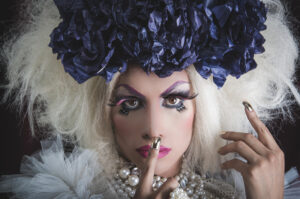Glamorous Journey – a trip, a wishful dream for the design of their lives that can easily be realized by all women or so advertising and media imply. In reality it not only fails due to material obstacles but also due to the rigid harness of female role clichés. How can literature inspired by feminism oppose these clichés?
As certain normative concepts define the female body in an unmistakable manner I am aware of the fact that any presentation/selfpresentation is a balancing act between subject and object positions, between self reflexion and feedback. My bisexual and lesbian protagonists waver in the limbo between traditional representations of femininity and the exploration of unknown territories. They shift those role clichés they are meant to fulfill.
Thus my heroines gain room to move for trying out new strategies.
THE WHEELING AND DEALING WITH FEMININITY
From the Romantic age onwards „femininity“ has been discovered as a critical concept that is able to counteract cultural and social tyranny. (Perthold 1991, 15). Today, the ‚dark’ female continent opposing the principle of rationality has been monopolised by the capitalist complex of fashion-, media- and leisure industries.
Commercial exploitation can swallow everything, even countercultures and utopian ideas. The Austrian Casting Show participant Tom Neuwirth redefined himself as Conchita Wurst – a bearded, longhaired, female artistic figure. Initially this travestie was maybe planned as an act of resistance, but very soon Conchita found herself as permanent guest in all kinds of TV-shows, talk shows and tabloids. Even the Austrian Broadcasting Company ORF used her as an envoy for a tolerant and modern Austria and sent her/him to the European Song contest, which she/he won in 2015 with a mix of an uncomparably glamorous performance, a great voice and the prophetic song ‚Rise Like A Phoenix’. All of that made her/him world famous.
Another example for the deliberate use of a surgically transformed body for marketing purposes can be found in the dance performance ‚The Crimson House’ choreographed by Polynesian artist Lemi Bonifasio. He cast the well-known transsexual artist Nina Arsenault rather as a decoy for an eager community instead of reflecting the position of transsexuality on stage. The main task of feminist literature may be to create powerful alternatives to these clichés and to bring to life heroines who are able to escape. In my literary texts I have created different versions of the Garçonne in a contemporary context. This is the common denominator of my protagonists.
GARÇONNE AS A BREAKAWAY
In the 1920ies the ‚Garçonne’, also called ‚flapper’ inspired female fantasies to break out of the economic and emotional dependency that heterosexual marriage had established as the only means of existence for women. The image of the ‚Garçonne’ emerged at a time when women started to engage in professional careers and earned their own money. The ‚Garçonne’ stood for a wide variation of – imagined or real – independent and thus regarded as dominant female characters – the rebel, the cruel woman, the duellant, the ‚femme d’attaque’, the artist, as well as all kinds of frauds. Mostly she appeared as bisexual, very often as a counterculture symbol for lesbian forms of expression (Hacker 1991). Sexual Science in the 1920ies even attributed her a third gender.
The ‚Garçonne’ also invaded the literary discourse of that era, which becomes obvious in the life and work of Austrian author Fritz von Herzmanovsky-Orlando: he fell in love with a whip-lashing libertine with Sapphic inclinations whom he married and tenderly called ‚my Panthera’. Moreover he wrote three novels whose heroes meet their death in encounters with unknown, powerful, idealized mannish women from dubious artistic backgrounds. In the novel ‚Maskenspiel der Genien’ this type of Garçonne appears as Cyparis, androgynous minstrel, nymph and warrior, who threatens to anihilate anything male – a stranger, an apparition, a dream character. Till today, male fears of distruction as well as their craving for salvation find their expression in this type of woman.
Luc Besson’s Science Fiction movie ‚The Fifth Element’ from 1997 shows Milla Jovovich as a sociophobic, rebellious, androgynous creature, who will eventually save the world. Two years later Besson creates another virginal-puerile saviour, which proves how seriously he takes the significance of the Garconne. His Jeanne d’Arc, again played by vigorous Jovovich is a modern role model for emancipated independent women.
Popstar Madonna is one of the most prominent contemporary icons who has constantly played with allusions to the Garconne in her shows and thus had a revolutionary influence on the 1980ies. These days she is being replaced by, according to the New York Times „postsexual“ Lady Gaga. While Madonna was eager to provoke for provocation’s sake, Lady Gaga’s concept is based on the deconstruction of identity-establishing reference systems. The eigthies are over and the Garconne no longer stands for fantasies of awakening nor a subversive eagerness to fight. Anorexic models – the incarnation of an obsession with beauty, youth and slimness are haunting fashion magazines and catwalks. Women function as mothers, career women and seductresses all around the clock – no escape seems possible.
COUNTERIMAGES NEED TO EMERGE
Even more so the Garçonne needs to be brought back to life in literature. My books give room to some variations of the garconne as rebel, as fighter between the mirrors of femininity. The lesbian or bisexual protagonists of my novels are strongheaded, ignore or parody dresscodes and undermine professional and political concepts.
Felicitas in ‚Côte d’Azur’ and ‚Sex Is The Answer’ is an elegant, sociably well-versed intellectual, constantly changing her role in love relationships: „Sometimes she is a passionate primadonna, then a tiny cuddly toy“ (Rick 1993,15) but she can kill with words, „her sentences hail down on the world“ (Rick 2006, 75). Anita, boisterous, sportive mother in „Twists Of Lust And Trust“ (in German: Chaosgirl) who climbs trees when her boys don’t, is a woman with a „a tousled boyishness, a kiss curl on her forehead, narrow waist but wide square shoulders, flat stomach, thin face and something tentative, almost awkward that touched me.’ (Rick 2009, 8).
Her life and her appearence are the synthesis of pure motherliness and the boyish-virginal style of a masculine-puerile character (as Herzmanovsky-Orlando would say). She is a jack-of-all-trades juggling the roles of mother and male daredevil. Nothing she does is based on immediate, positive female role models and most of her actions are doomed to fail.
LET’S BRING IN THE AMAZONES
Amazonian qualities suit perfectly well to set on stage the figure of the unruly woman. Gini in „Furien in Ferien“ is a vagabond, a political activist who constantly fights with state authorities and acts from the margins of society. Kaye, the leather-woman in „Sex is the answer“ impersonates the hustler as well as the vulgar domina in sexual encounters.
„She enters the room, dressed in a tight leather skirt, naked shoulders, black tights. Black high heels. Her clothes don’t agree with her body. She is clearly not a lady but a rascal, a stray with a yellow-red strand swapping across her face. And now this skirt! A masquerade. Tacky.“(Rick 2006, 63)
THE MYTH OF BEAUTY
In 1990 Naomi Wolf defined the female cult of beauty as a new fundamentalism, which stands in the way of the newly gained freedom for women. With its archaic rites, sacraments and control systems like beauty contests this new religion influences politics, society and the economics of an entire era. Photographers, jurors, journalists and even the ordinary man in the street represent an allegedly superior divine authority. Beauty functions as currency. Beauty is a job qualification for women. Beauty must be acquired especially by women, equals youth and thus results in the boom of plastic surgery and modelling.
Recently the situation has changed. Also men undergo plastic surgery and use cosmetics. For them physical fitness which proves a readiness to shape their bodies has become a job qualification. Moreover, in addition to 16-year-olds also silver models like Evelyn Hall, aged 65, actress, ballerina and model appear on catwalks. They create new trends and make the public aware of age. For commercial reasons divas survive and grow old along with us. The femme fatale does not have an expiry date anymore. The scale of images ranges from sex symbols like Marilyn Monroe to androgynous Tilda Swinton. Minor flaws transform into trademarks. Barely recognizable holes in the system of a smooth, exchangeable fassade evoke emotional reactions in the eye of the beholder.
Felicitas in ‚Sex Is The Answer’ is especially loveable when her make-up gets smeared: „She takes off her glasses and I see that her eyes are tired. Her mascara is smudged, and thus her face seems destroyed in an attractive way. (…) A quiet, little sigh escapes me, saying, ‚I am yours forever’.“ (Rick, 2006,99)
TRICKSTER AS AN OPTION
I finally hold a plea for the renaissance of the character of the female trickster in literature. It is an ambivalent and cunning person and thus a suitable option for female behaviour. It embodies the unification of opposites. Madonna is sometimes called a trickster. „She, ‚the sly fox of pop business’ diverts us from the revolutionary, antireligious content of her music by using outrageous, monumental images.“ (Caramanica).
Anita in ‚Twists Of Lust And Trust’ acts as a spanner in the works of the state’s control system and cunningly subverts its mechanisms. My writing is about reanimating Amazonian principles and lifestyles which have never really died.
BIBLIOGRAPHY
CARAMANICA, JON (2010): The Age of Gaga Rages Absurdly On, in: The New York Times, August 2
HACKER, HANNA (1991): Es ist eben ein Malheur wie jedes andere, in: Rote Küsse, ein Filmschaubuch; Sabine Perthold (Hg.). Tübingen
HERZMANOVSKY-ORLANDO, FRITZ von (1989): Das Maskenspiel der Genien, (Österreichische Trilogie III). SW., Bd III; Susanne Goldberg (Hg.) Salzburg und Wien
PERTHOLD, SABINE (1991): Zeigt her eure Zähne, in: Rote Küsse, ein FilmSchauBuch; Sabine Perthold (Hg.). Tübingen
RICK, KARIN (1993): Cote d’azur – zwei Frauen, eine Liebesgeschichte, Erzählung. Wien
RICK, KARIN (2004): Furien in Ferien – ein Lesbosabenteuer, Roman. Berlin
RICK, KARIN (2006): Sex ist die Antwort, Roman, Neuauflage. Tübingen
RICK, KARIN (2009): Chaosgirl, Roman. Tübingen
WOLF, NAOMI (1991): Der Mythos Schönheit. Reinbek bei Hamburg
Karin Rick, Glamorous Journey, Essay in: aep, Feministische Zeitschrift für Politik und Gesellschaft, Nr. 2/2014, Innsbruck. Translated into English by Eva Stiegler.




